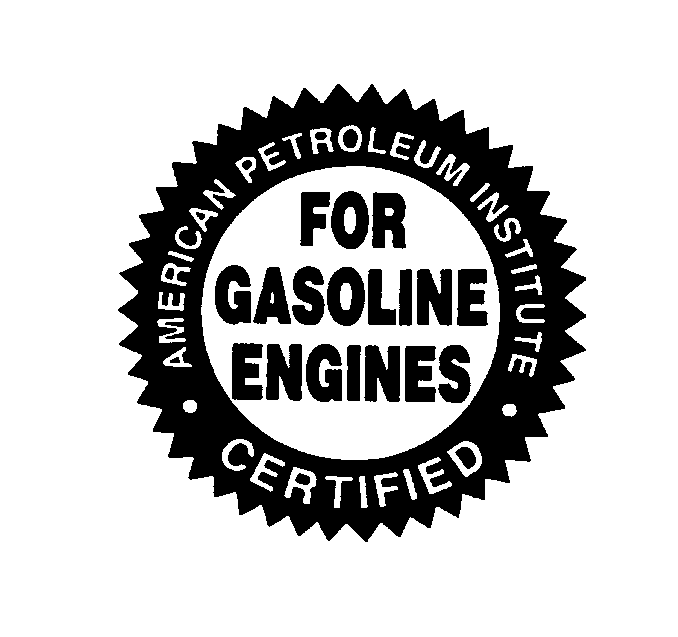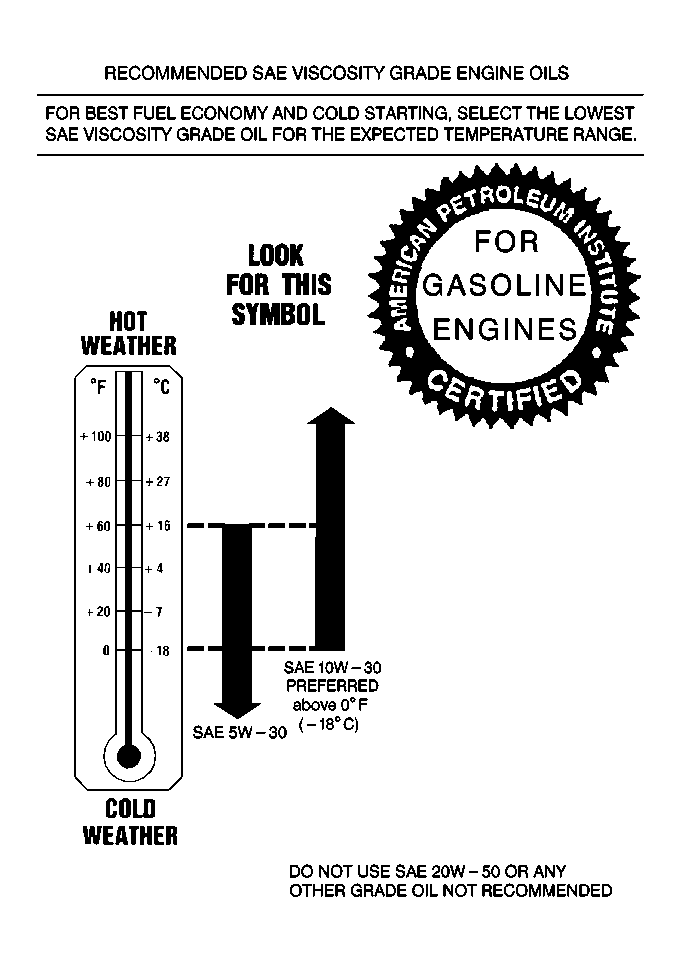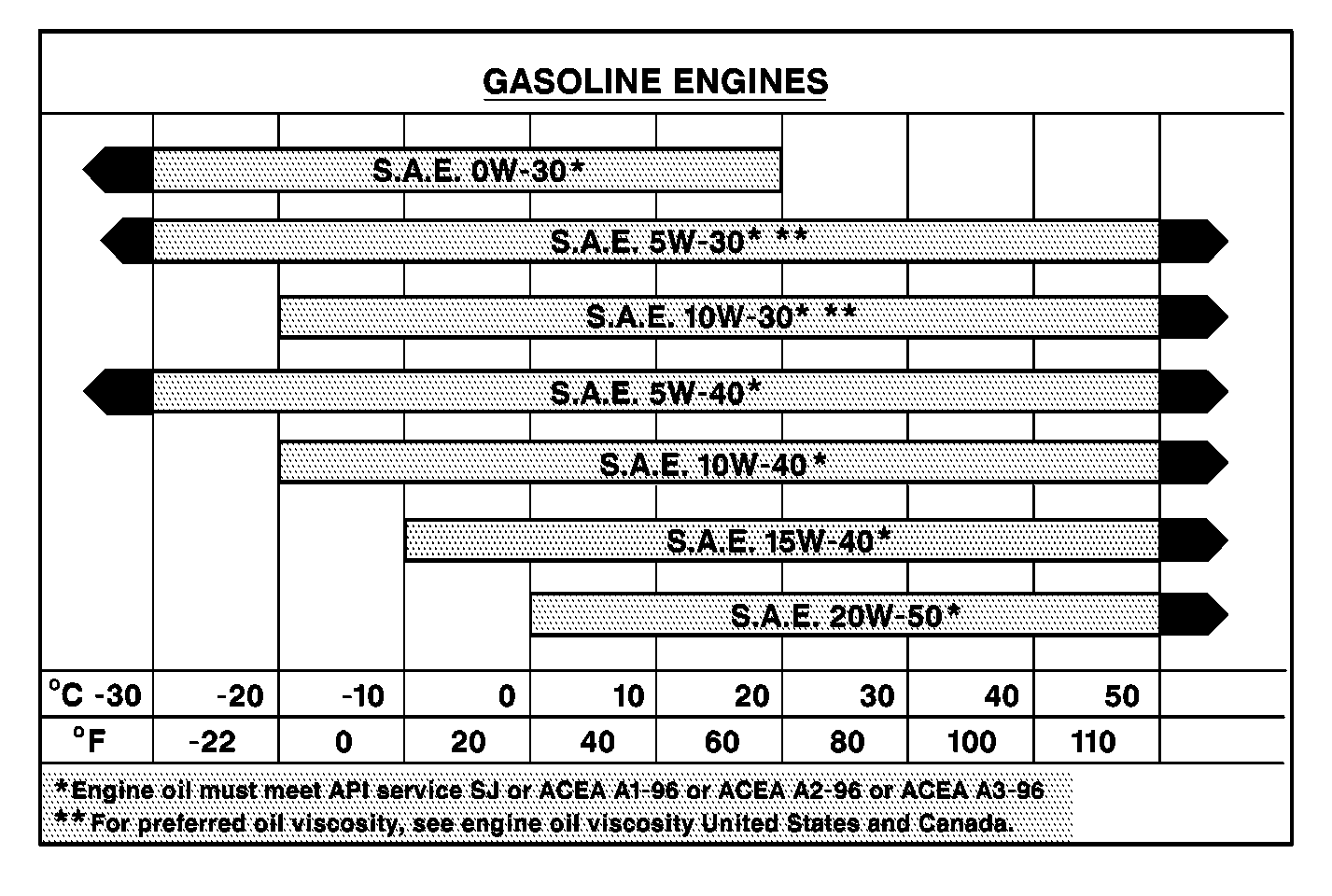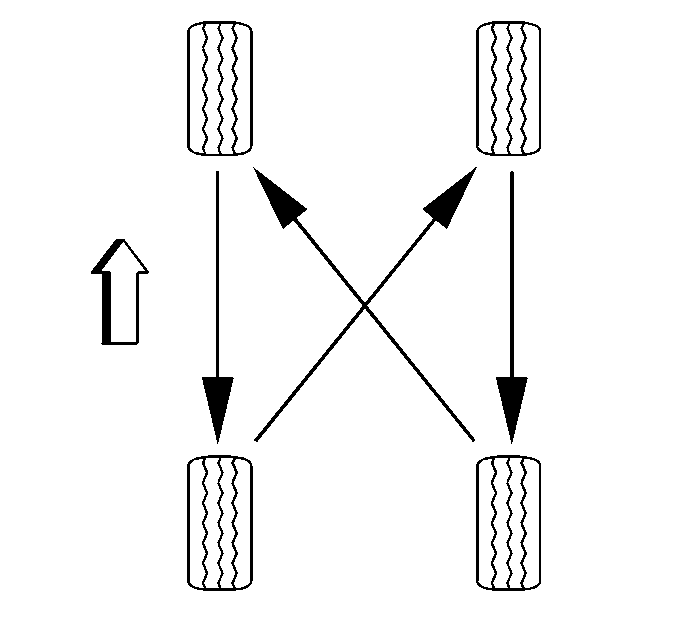For time and/or mileage intervals of scheduled maintenance items, refer to Maintenance Items .
The following text and illustrations describe the details of the required scheduled maintenance services.
For information on the proper fluids and lubricants to use, refer to Fluid and Lubricant Recommendations .
Engine Oil and Filter Change
For the engine oil and filter changing procedure, refer to Engine Oil and Oil Filter Replacement in Engine Mechanical.
For information on the correct engine oil quality and viscosity, refer to the following:
Engine Oil Quality United States and Canada

Notice: Use only engine oil with the American Petroleum Institute Certified for Gasoline Engines starburst symbol. Failure to use the recommended oil can result in engine damage not covered by the warranty.
The STARBURST symbol indicates that the oil has been certified by the American Petroleum Institute (API). Do not use any oil which does not carry the STARBURST symbol.
Engine Oil Viscosity, United States and Canada

Notice: Using oils of any viscosity other than those recommended could result in engine damage. When choosing an oil, consider the range of temperatures the vehicle will be operated in before the next oil change. Then, select the recommended oil viscosity.
SAE 10W-30 is the recommended engine oil viscosity. Engine oil viscosity thickness has an effect on the fuel economy and the cold-weather operation engine starting and oil flow. Lower viscosity engine oils can provide better fuel economy and cold-weather performance. However, higher temperature weather conditions require higher viscosity engine oils for satisfactory lubrication. When the temperature is consistently lower than 16°C (60°F), 5W-30 may be used. SAE 20W-50 or oils of other viscosity rating or quality designations are NOT recommended for use in any GMC vehicle at any time.
Engine Oil Quality and Viscosity Other Than The United States and Canada

Important: When adding to, or changing the engine oil, use ONLY oils of the proper quality.
In countries other than the United States and Canada, it may be difficult to find engine oils that display the API STARBURST symbol certifying the oil is for use in gasoline engines. If you are unable to find engine oils displaying the API STARBURST symbol, use engine oils that meet API Service SJ and/or ACEA A1-96, ACEA A2-96, or ACEA A3-96 requirements as shown in the chart above.
Tire and Wheel Inspection
Tires should be rotated every 7,500 miles (12 500 km).
Caution: Rust or dirt on a wheel, or on the parts to which it is fastened, can make wheel nuts become loose after a time. The wheel could come off and cause an accident. When you change a wheel, remove any rust or dirt from places where the wheel attaches to the vehicle. In an emergency, you can use a cloth or a paper towel to do this; but be sure to use a scraper or wire brush later, if you need to, to get all the rust or dirt off.
Notice unusual wear, rotate your tires as soon as possible and check wheel alignment. Also check for damaged tires or wheels. For tire diagnosis information, refer to Tire Diagnosis - Irregular or Premature Wear in Tires and Wheels.
For wheel alignment diagnosis information, refer to Diagnostic Starting Point - Suspension General Diagnosis in Wheel Alignment.
The purpose of regular rotation is to achieve more uniform wear for all tires on the vehicle. The first rotation is the most important. Refer to Maintenance Schedule or for scheduled rotation intervals.

When rotating your tires, always use the correct rotation pattern shown here. Do not include the spare tire in your tire rotation.
After the tires have been rotated, adjust the front and rear inflation pressures as shown the Tire-Loading Information label.
Make certain that all wheel nuts are properly tightened. Refer to Fastener Tightening Specifications in Tires and Wheels.
Brake System Inspection
Inspect the complete system. Inspect brake lines and hoses for proper hook-up, binding, leaks, cracks, chafing, etc. Inspect disc brake pads for wear and rotors for surface condition. Inspect other brake parts, including calipers, parking brake, etc. The brakes may need to be inspected more often if driving habits or conditions result in frequent braking.
Accessory Drive Belt Inspection
Inspect the accessory drive belts for the following:
| • | Cracks |
| • | Fraying |
| • | Wear |
| • | Proper tension |
Replace as needed. Belts can have many small cracks in individual ribs without affecting the performance. Refer to Drive Belt Replacement .
Automatic Transmission
Change both the fluid and the filter according to the maintenance schedule intervals. For maintenance schedule information, refer to Maintenance Schedule .
For the fluid and filter changing procedure, refer to Automatic Transmission Fluid and Filter Replacement in Automatic Transmission.
Spark Plug Replacement
Replace the spark plugs according to the maintenance schedule intervals with the correct type. For maintenance schedule information, refer to Maintenance Schedule .
For information on the correct type of spark plug, refer to Maintenance Items .
Timing Belt Replacement
Notice: Failure to follow the described timing belt inspection and maintenance may result in a broken timing belt and cause severe engine damage.
Replace the timing belt at 100,000 miles (160 000 km). The J 42069 Timing Belt Alignment Kit special tool must be used to properly install and adjust the belt. If the belt is improperly installed of the belt is improperly adjusted the following will be seriously affected:
| • | The vehicle emissions |
| • | The driveability |
| • | The belt life |
Engine damage will occur if the belt fails. Refer to Timing Belt Replacement in Engine Mechanical for belt replacement and adjustment procedures.
For the spark plug replacement procedure, refer to Spark Plug Replacement in Engine Controls.
Fuel Filter Replacement
Replace the fuel filter every 160 000 km (100,000 mi). Refer to Fuel Filter Replacement in Engine Controls.
Cooling System Service
Notice: When adding coolant, use DEX-COOL® coolant. If silicated coolant is added to the system, premature engine, heater core or radiator corrosion may result. In addition, the engine coolant will require change sooner-at 50 000 km (30,000 mi) or 24 months.
This vehicle was manufactured with GM Goodwrench DEX-COOL® orange colored, silicate free when coolant is added or when coolant is changed. Refer to Cooling System Draining and Filling in Engine Cooling for draining and refilling procedure. Add 2 engine coolant supplement pellets, GM P/N 3634621 (Canadian P/N 10953473) or equivalent, when refilling the system.
Air Cleaner Filter Replacement
Replace the air cleaner filter according to the maintenance schedule intervals with the correct type. For maintenance schedule information, refer to Maintenance Schedule .
For information on the correct type of air cleaner filter, refer to Maintenance Items .
For the air cleaner filter replacement procedure, refer to Spark Plug Replacement in Engine Controls.
Passenger Compartment Air Filter Pollen Filter Replacement
The passenger compartment air filter is located in the air inlet for the heater and air conditioning module, under the passenger side air inlet grille leaf screen. Refer to Passenger Compartment Air Filter Replacement in HVAC with Automatic A/C.
Rear Axle Service
Check the gear lubricant level in the rear axle and add if needed. Refer to Fluid and Lubricant Recommendations . A fluid loss may indicate a problem. Check the axle and repair if needed. Refer to Rear Axle Lubricant Level Inspection in Rear Axle.
